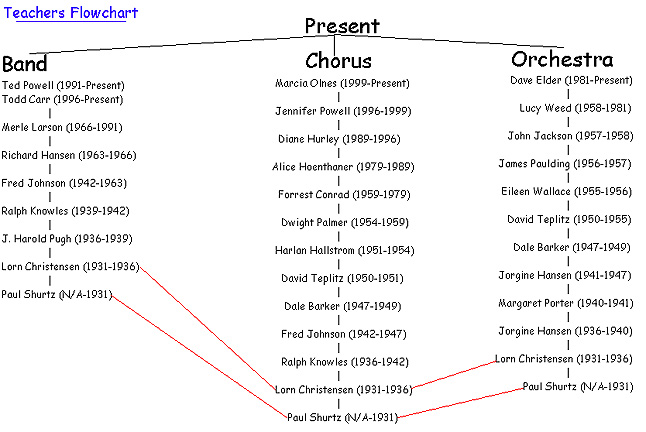|
Reference and Fun Stuff
Composers A-Z |
|
Miscellaneous |


My High School Music Department History
This article was originally an assignment for my journalism class my sophomore year in school, but the more research I did, the more I really got into the project. While you're here, check out the "Teachers Flowchart," which traces back band, choir, and orchestra teachers through 1919.
Music Programs Undergo Many Changes at YHS
February, 2001
The music programs at YHS have changed immensely since they started.
In 1921, a Mr. Watson started the band because if other schools could have a band, then so should Yankton High School. The band had 43 members playing cornets, saxophones, baritones, tubas, and drums.
Suprisingly, by 1929, the numbers were not even half that much. At that time, the band, all boys, wore military-style uniforms with short hats and dress pants and jackets. During the 1930s, numbers increased.
The band had between 30-40 members, but we had a solid program, said George Means, class of 1937. At that time, the band competed at state contests but did not march.
Until 1936, Lorn Christensen taught band, chorus, and orchestra.
By 1950, the program had grown extensively. Membership had grown to 60 members, hence, the name The Marching Sixty. The band had several quartets, as well as three majorettes and a German Band.
Funding grew to accommodate growing interest. Now the school owned more instruments for the increasing number of band students and director Fred Johnson (1942-1962) led them to first places at state contests.
In 1966, Merle Larson took over for Dick Hansen, who had directed the band from 1963-1966. Larson added trips to the bands schedule. Larson led the band for 24 years before moving to the middle school and then retiring in 1999.
In 1991, Ted Powell came to the school, and the band continued to expand.
In 1994, an important development occurred when band became a part of the school day. Before this, the band rehearsed for an hour to an hour and a half before school.
The 150 band members are united during marching season and separated during concert season.
The entire band and individual members have received high honors and made trips as far away as California, Florida, and Chicago.
The choral program dates back to the 19th century, and YHS has also supported glee clubs.
In 1929 the chorus had 25 members, and they won first place in both the state and district contests.
In 1950, under the direction of choral teacher David Teplitz, the chorus performed the musical Pinafore. The show was so successful that a tradition of musical theatre began at the high school.
The students loved him (Teplitz), said his wife. He made the program fun, and they would come to his office after school just to hang around.
At that time, there was an A Cappella choir made up of about 60 students who were a professional sounding, mature choir. The choir also performed operas, including The Telephone.
By the 1960s the choral program owned a new set of choral robes and had grown immensely.
Also, Forrest Conrad, 1959-1979, made many contributions to the choral program.
In 1979, the choral director was Alice Hoenthaner, who initiated a mixed, boys, girls, and madrigal choir. They practiced apart but performed together.
"Anyone who wanted to sing was welcome in my group," she said. Honors Choir and All-State Choir were open to all who wished to audition.
Under the capable direction of Diane Hurley and Jennifer Powell, choir programs continued to expand. Marcia Olnes is the dynamic current vocal music director. The choral program currently includes four choirs, A Cappella, Concert, Girls, and Mixed Choirs, plus two jazz choirs.
The orchestral program was around before 1917, and consisted of up to 23 members at a time.
The orchestra had many dedicated, talented directors. Lucy Weed came in 1959, and she was extremely good at her profession. She was known to have reached out during a performance to tune violins that were not quite in tune.
Weed taught David Elder, who took over for her in 1981 when she retired.
The orchestra, now consisting of mainly strings, once included wind and percussion instruments, which are now part of the band curriculum.
*Updates*
-Until 2001, each fine arts class, including music courses, were given 1/2 credit per class per year. In 2001, this was changed, and now each course gets one full credit per year.
-In 2001, Julie Amsberry replaced Marcia Olnes as Choir director.